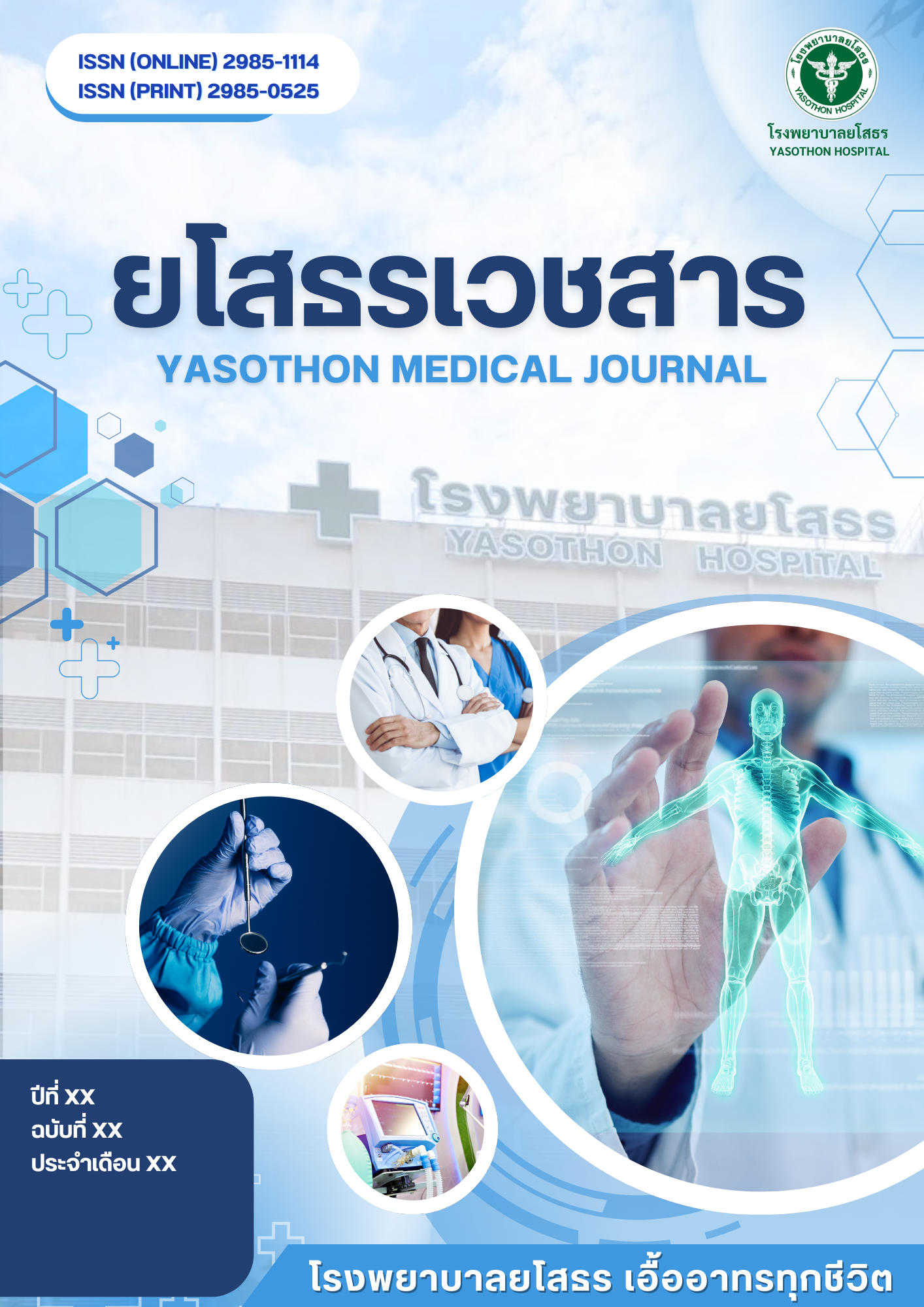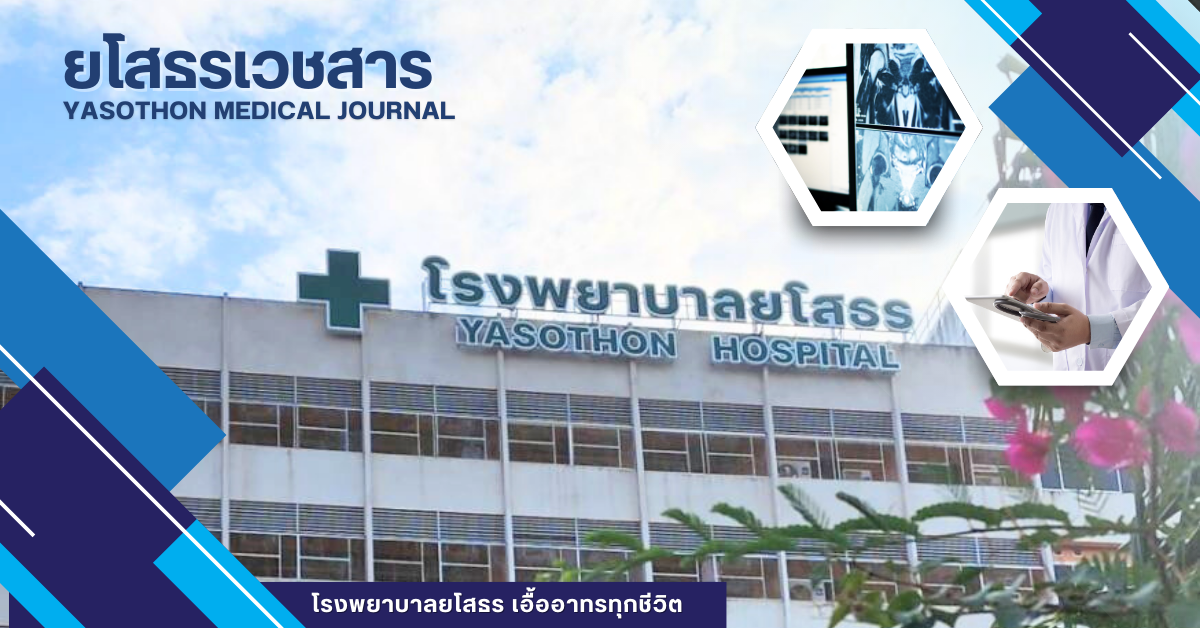การคัดกรองการได้ยินในทารกแรกเกิดด้วยเครื่องตรวจวัดเสียงสะท้อนจากหูชั้นใน ของโรงพยาบาลสมเด็จพระยุพราชเดชอุดม จังหวัดอุบลราชธานี
คำสำคัญ:
การคัดกรองการได้ยิน, ทารกแรกเกิด, เสียงสะท้อนจากหูชั้นใน, ภาวการณ์ได้ยินบกพร่อง, ปัจจัยเสี่ยงบทคัดย่อ
บทนํา: การได้ยินเป็นส่วนสำคัญของการพัฒนาภาษา โดยเฉพาะอย่างยิ่งในช่วงสามปีแรกของชีวิต การสูญเสียการได้ยินในทารกแรกเกิดในระยะเริ่มต้นอาจนำไปสู่การสื่อสารและพัฒนาการที่สำคัญ การวินิจฉัยและการฟื้นฟูสมรรถภาพอย่างทันท่วงทีสามารถช่วยให้เด็กมีพัฒนาการด้านภาษาใกล้เคียงกับเด็กปกติ
วัตถุประสงค์: ศึกษาความชุกและปัจจัยที่สัมพันธ์กับการไม่ผ่านการคัดกรองการได้ยินในทารกแรกเกิดที่โรงพยาบาลสมเด็จพระยุพราชเดชอุดม จังหวัดอุบลราชธานี
วิธีการ: การศึกษาย้อนหลังจากข้อมูลเวชระเบียนของทารกแรกเกิด 2,144 ราย ที่ได้รับการคัดกรองการได้ยินด้วยเครื่อง OAE ระหว่างวันที่ 1 ตุลาคม 2565 ถึง 30 กันยายน 2566 การวิเคราะห์ข้อมูลใช้สถิติเชิงพรรณนาและการวิเคราะห์ความสัมพันธ์โดยใช้ Chi-Square Test, Fisher's Exact Test, T-Test, Mann-Whitney U Test และ Logistic Regression Analysis โดยกำหนดนัยสำคัญทางสถิติที่ p < 0.05
ผลลัพธ์: ทารกแรกเกิดทั้งหมด 2,144 ราย ทารกร้อยละ 98.93 ผ่านการตรวจคัดกรอง มีเพียงร้อยละ 1.07 (23 ราย) ที่ต้องได้รับการติดตามเพิ่มเติม สามารถติดตามได้ 17 ราย (ร้อยละ 73.91) พบความผิดปกติที่ต้องการการรักษา 7 ราย ปัจจัยเสี่ยงที่มีนัยสำคัญทางสถิติจากการวิเคราะห์ตัวแปรพหุ ได้แก่ ภาวะติดเชื้อในกระแสเลือด (Adjusted OR = 9.82, p < 0.01) และภาวะเลือดข้น (Adjusted OR = 7.16, p = 0.004) แม้ว่าทารกที่มารดาไม่ได้ฝากครรภ์และทารกที่มารดาติดเชื้อเอชไอวี จะแสดงโอกาสที่สูงขึ้น แต่ก็ไม่มีนัยสําคัญทางสถิติ
สรุป: การคัดกรองการได้ยินในทารกแรกเกิดมีความสำคัญอย่างยิ่งในการตรวจพบความผิดปกติ ปัจจัยเสี่ยงที่สำคัญคือภาวะติดเชื้อในกระแสเลือดและภาวะเลือดข้น การเฝ้าระวังและการตรวจติดตามอย่างใกล้ชิดเป็นสิ่งจำเป็นในกลุ่มทารกที่มีความเสี่ยงสูง และการตรวจคัดกรองตั้งแต่เนิ่น ๆ มีความสำคัญในการระบุทารกที่มีความเสี่ยงและได้รับการรักษาได้อย่างทันท่วงที
เอกสารอ้างอิง
Robert JE, Wallace IF, Brackett D. Development of speech and language. In: Lalwani AK, Grundfast KM, editors. Pediatric otology and neurology. Philadelphia: Lippincott-Raven; 1998. p. 39-47.
สุนันทา พลปัถพี, นิตยา เกษมโกสินทร์. ความบกพร่องทางการได้ยินในเด็ก. ใน: กิ่งแก้ว ปาจรีย์, บรรณาธิการ. การฟื้นฟูสมรรถภาพเด็กพิการ. กรุงเทพฯ; กรีนพริ้น; 2542. หน้า 217-27.
Yoshinaga-Itano C. Efficacy of early identification and early intervention. Semin Hear 1995; 16(2): 115-22. doi: 10.1055/s-0028-1083709.
Apuzzo ML, Yoshinaga-Itano C. Early identification of infants with significant hearing loss and the Minnesota child development inventory. Semin Hear 1995; 16(2): 124-35. doi: 10.1055/s-0028-1083710.
Yoshinaga-Itano C, Sedey AL, Coulter DK, Mehl AL. Language of early and later-identified children with hearing loss. Pediatrics 1998; 102(5): 1161-71. doi: 10.1542/peds.102.5.1161.
Downs MP, Yoshinaga-Itano C. The efficacy of early identification and intervention for children with hearing impairment. Pediatr Clin North Am 1999; 46(1): 79-87. doi: 10.1016/s0031-3955(05)70082-1. PubMed PMID: 10079791.
Robinshaw HM. Early intervention for hearing impairment: differences in the timing of communicative and linguistic development. Br J Audiol 1995; 29(6): 315-34. doi: 10.3109/03005369509076750. PubMed PMID: 8861408.
Davis A, Mencher G. Epidemiology of permanent childhood hearing impairment. In: Newton VE, editor. Pediatric audiological medicine. London: Whurr; 2002. p. 65-90.
Fortnum HM, Summerfield AQ, Marshall DH, Davis AC, Bamford JM. Prevalenceof permanent childhood hearing impairment in the United Kingdom and implications for universal neonatal hearing screening: questionnaire based ascertainment study. BMJ 2001; 323(7312): 536-40. doi: 10.1136/bmj.323.7312.536. PubMed PMID: 11546698.
Wessex Universal Neonatal Hearing Screening Trial Group. Controlled trial of universal neonatal screening for early identification of permanent childhood hearing impairment. Lancet 1998; 352(9145): 1957-64. PubMed PMID: 9872244.
Chareonsil R. Results of the Sawanpracharak newborn hearing screening program. BSCM 2015; 54(2): 81-8.
Tungvachirakul V, Boonmee S, Nualmoosik T, Kamjohnjiraphun J, Siripala W, Sanghirun W, et al. Newborn hearing screening at Rajavithi Hospital, Thailand: hearing loss in infants not admitting in intensive care unit. J Med Assoc Thai 2011; 94 Suppl 2: S108-12. PubMed PMID: 21717888.
Colella-Santos MF, Hein TA, de Souza GL, do Amaral MI, Casali RL. Newborn hearing screening and early diagnostic in the NICU. Biomed Res Int 2014; 2014: 845308. doi:10.1155/2014/845308. PubMed PMID: 24999481.
Khaimook W, Chayarpham S, Dissaneevate S. The high-risk neonatal hearing screening program in Songklanagarind Hospital. J Med Assoc Thai 2008; 91(7): 1038-42. PubMed PMID: 18839842.
Srisuparp P, Gleebbur R, Ngerncham S, Chonpracha J, Singkampong J. High-risk neonatal hearing screening program using automated screening device performed by trained nursing personnel at Siriraj Hospital: yield and feasibility. J Med Assoc Thao 2005; 88 Suppl 8: S176-82. PubMed PMID: 16856439.
Kiatchoosakun P, Suphadun W, Jirapradittha J, Yimtae K, Thanawirattananit P. Incidence and risk factors associated with hearing loss in high-risk neonates in Srinagarind Hospital. J Med Assoc Thao 2012; 95(1): 52-7. PubMed PMID: 22379742.
Nelson HD, Bougatsos C, Nygren P, 2001 US Preventive Services Task Force. Universal newborn hearing screening: systematic review to update the 2001 US preventive services task force recommendation. Pediatics 2008; 122(1): e266-76. doi: 10.1542/peds.2007-1422. PubMed PMID: 18595973.
Thompson DC, McPhillips H, Davis RL, Lieu TL, Homer CJ, Helfand M. Universal newborn hearing screening: summary of evidence. JAMA 2001; 286(16): 2000-10. doi: 10.1001/jama.286.16.2000. PubMed PMID: 11667937.
Khaimook W, Chayarpham S, Dissaneevate S. The high-risk neonatal hearing screening program in Songklanagarind Hospital. J Med Assoc Thai 2008; 91(7): 1038-42.
World Health Organization. Deafness and hearing loss [Internet]. 2025 [Cited 2025 Mar 22]. Available from: https://www.who.int/news-room/fact-sheets/detail/deafness-and-hearing-loss
จันทร์ชัย เจรียงประเสริฐ, กฤษณา เลิศสุขประเสริฐ, ลลิดา เกษมสุวรรณ, ประชา นันทนฤมิตร. การตรวจคัดกรองการได้ยินในทารกแรกเกิดด้วยเครื่องวัดเสียงสะท้อนจากหูชั้นใน (Otoacoustic emission) ผู้ป่วยใหม่ใน 1 ปี ของโรงพยาบาลรามาธิบดี. วารสารหู คอ จมูก และใบหน้า 2546; 4: 27-41.
American Academy of Pediatrics, Joint Committee on Infant Hearing. Year 2007 position statement: principle and guildlines for early hearing detection and intervention program. Pediatrics 2007; 120(4): 898-921. doi: 10.1542/peds.2007-2333. PubMed PMID: 17908777.
Durieux-Smith A, Fitzpatrick E, Whittingham J. Universal newborn hearing screening: a question of evidence. Int J Audiol 2008; 47(1): 1–10. doi: 10.1080/14992020701703547. PubMed PMID: 18196481.
Nelson HD, Bougatsos C, Nygren P. Universal newborn hearing screening: systematic review to update the 2001 U.S. preventive services task force recommendation [Internet]. Rockville (MD): Agency for Healthcare Research and Quality (US) 2008; Report No.: 08-05117-EF-1. PubMed PMID: 20722159.
Hyde ML. Newborn hearing screening programs: overview. J Otolaryngol 2005; 34 Suppl 2: S70-8. PubMed PMID: 16076420.
Karchmer MA, Allen TE. The functional assessment of deaf and hard of hearing students. Am Ann Deaf 1999; 144(2): 68–77. PubMed PMID: 10369003.
Anne S, Lieu JEC, Cohen MS. Speech and language consequences of unilateral hearing loss: a systematic review. Otolaryngol Head Neck Surg 2017; 157(4): 572–9. doi: 10.1177/0194599817726326. PubMed PMID: 28828919.
White KR, Vohr BR, Behrens TR. Universal newborn hearing screening using transient evoked otoacoustic emission: results of the Rhode Island hearing assessment project. Semin Hear 1993; 14: 18-29.
ธนากิจ ชวยบุญชุม, รัตตินันท์ ฏิระวณิชย์กุล, นภมนต์ มงคลานันท์กุล, วรพันธุ์ เปรมไกรสร. การตรวจคัดกรองการได้ยินในทารกแรกเกิดของโรงพยาบาลรามาธิบดี. รามาธิบดีเวชสาร มิถุนายน-กันยายน 2558; 38(3): 197-208.
Maro II, Fellows AM, Clavier OH, Gui J, Rieke CC, Wilbur JC, et al. Auditory impairment in HIV-infected children. Ear Hear 2016; 37(4): 443-51. doi: 10.1097/AUD.0000000000000276. PubMed PMID: 26881980.
Torre P 3rd, Zeldow B, Hoffman HJ, Buchanan A, Siberry GK, Rice M, et al. Hearing loss in perinatally HIV-infected and HIV-exposed but uninfected children and adolescents. Pediatr Infect Dis J 2012; 31(8): 835-41. doi: 10.1097/INF.0b013e31825b9524. PubMed PMID: 22549437.
Khoza-Shangase K. Hearing loss in HIV-exposed but uninfected children: Advocating for the role of audiologists in South Africa. S Afr J Commun Disord 2025; 72(1): e1-e5. doi: 10.4102/sajcd.v72i1.1084. PubMed PMID: 40171706.
รุ่งกานต์ เพชรล้วน. อุบัติการณ์ของการสูญเสียการได้ยินในทารกตรวจคัดกรองด้วยเครื่องตรวจวัดเสียงสะท้อนจากหูชั้นใน โรงพยาบาลตะกั่วป่า. กระบี่เวชสาร ตุลาคม 2562 – มิถุนายน 2563; 3(1): 1-8.
ปิยวรรณ ทองศรีนุช, ศิรินันท์ จั่นทอง. การศึกษาความชุกการคัดกรองการได้ยินและการรักษาฟื้นฟูการได้ยินบกพร่องในทารกแรกเกิดในคณะแพทยศาสตร์วชิรพยาบาล. วชิรเวชสารและวารสารเวชศาสตร์เขตเมือง 2564; 65(Suppl พฤศจิกายน): S39-52.
Kenna MA. Acquired hearing loss in children. Otolaryngol Clin North Am 2015; 48(6): 933-53. doi: 10.1016/j.otc.2015.07.011. PubMed PMID: 26452421.
Humphrey S, Davidson J, Brodsky L. Neonatal sepsis and hearing loss: Auditory complications of neonatal infections. Pediatr Infect Dis J 2019; 38(8): 869-75.
Anand VR, Jayachandran S, Kumar RK. Neonatal sepsis and auditory function: A study of hearing impairment among neonates with sepsis in a tertiary care hospital. Int J Pediatr Otorhinolaryngol 2020; 134: 110032.
Ultee CA, van der Deure J, Lafeber HN. Neonatal polycythemia and hearing loss: A case study on the risk of severe hyperviscosity. Pediatr Res 2008; 62(5): 604-9.
Shankaran S, Bell EF, Laptook AR. Neonatal polycythemia: Early management and outcomes in newborns with high hematocrit levels. J Pediatr 2010; 157(2): 194-8.
Armentrout D, Christensen RD, Wiedmeier SE. Polycythemia in term newborns: Trends in incidence and association with abnormal hearing tests. Neonatology 2016; 109(3): 164-9.
Wickremasinghe AC, Risley RJ, Kuzniewicz MW, Wu YW, Walsh EM, Wi S, et al. Risk of sensorineural hearing loss and bilirubin exchange transfusion thresholds. Pediatrics 2015; 136(3): 505–12. doi: 10.1542/peds.2014-3357. PubMed PMID: 26283777.
ดาวน์โหลด
เผยแพร่แล้ว
รูปแบบการอ้างอิง
ฉบับ
ประเภทบทความ
สัญญาอนุญาต
ลิขสิทธิ์ (c) 2025 ยโสธรเวชสาร

อนุญาตภายใต้เงื่อนไข Creative Commons Attribution-NonCommercial-NoDerivatives 4.0 International License.
บทความที่ได้รับการตีพิมพ์เป็นลิขสิทธิ์ของยโสธรเวชสาร







